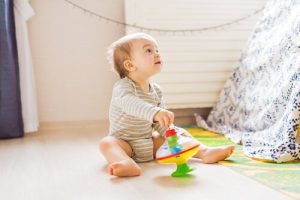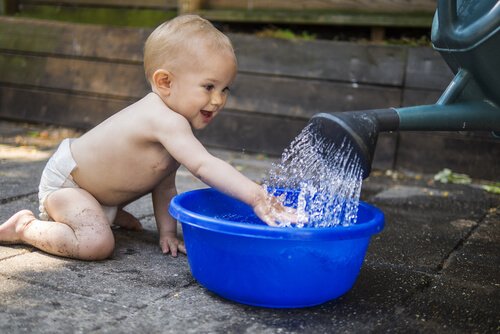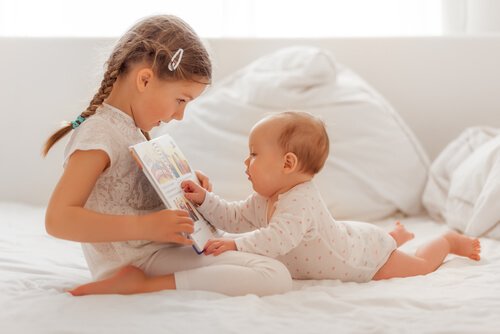Curiosity in Children: Characteristics and Multiple Benefits

Curiosity is a tool that children use for learning. Some parents may inadvertently see curiosity in children as an unwelcome or negative quality. This can lead them to curtail their child’s natural curiosity.
How can you keep your child’s curiosity alive? The following are incredibly useful suggestions.
How to define curiosity
Curiosity is the natural instinct that implies wanting to know more about something through research and interaction. It encourages people to seek new information, interact with their environment and the people who surround them. This instinct also stimulates personal growth.
Children are little explorers. They’re born with innate curiosity. They try to interact with everything by touching, looking and observing the objects and people around them.
By asking questions such as “why?” or “how?” they’re able to obtain useful information.

Main characteristics of curiosity in children
As parents, it’s important for us to care for and enhance our children’s curiosity. By taking these steps we’ll be able to help them learn more efficiently. Don’t let your child lose any of the following characteristics:
- Interest
- Motivation
- Desire
- Restlessness
- Passion
3 ways to motivate the brain to learn
Curiosity about a subject makes it much easier to learn, retain and assimilate information about it. The expectation generated by curiosity motivates the brain to assimilate knowledge better because:
- It activates dopamine, which is a chemical messenger or neurotransmitter to achieve objectives. It also promotes the retention of information.
- Curiosity provides benefits for the hippo-campus, which is one of the brain’s centers. The hippo-campus is fundamental for the formation and consolidation of both long and short-term memory.
- The tandem or reward system facilitates learning and the reception of information.
The importance of stimulating curiosity in children
It’s very important to stimulate curiosity in children because it sparks interest which is necessary for them to learn and develop their thoughts. Children who aren’t curious may be:
- Less sociable.
- Read fewer books.
- Difficult to inspire, motivate and enthuse.
- Show little interest in learning new things.
Benefits of curiosity in children
As soon as they start talking, children start to ask questions. The fact that they keep their curious eyes wide open to the world to learn new things brings about many benefits including:
- Strengthening their relationships with others.
- Protecting their brains.
- Helping them grow.
- Helps them overcome anxiety.
3 negative habits that affect curiosity
There are 3 habits that can affect the development of curiosity negatively in your child.
Fear is the enemy
Fear is the number one enemy of curiosity. Overprotecting your child as a parent will only generate more fear. It will also produce feelings of incompetence.
Avoid using phrases such as: “Don’t touch that because you’re going to get hurt” or “Don’t run, you’re going to fall.” Allow your child to get interested in exploring new things.

Disapproval represses
Children always want to play and explore. It’s not wise to constantly say “don’t do that”, “don’t get dirty” or “be quiet.”
These phrases hold them back and inhibit them from being curious. It’s okay for you to use some of these phrases from time to time as long as they’re justified and you explain your reasoning to them.
Absence produces insecurity
Your children feel safe when you’re by their side. Feeling safe will help them develop their curiosity even more. By playing with your children, you’ll also give them the opportunity to share what they learn with you.
In conclusion, to stimulate curiosity in children, you have to dedicate time to them. You have to listen to them and reinforce their behavior positively. Curiosity will help them face their challenges in the future. By helping them develop their curiosity you’ll also help them develop great self-esteem.
All cited sources were thoroughly reviewed by our team to ensure their quality, reliability, currency, and validity. The bibliography of this article was considered reliable and of academic or scientific accuracy.
- Gonzáelez, J. V. R. (2016). La curiosidad en el desarrollo cognitivo: análisis teórico. Folhmyp, (6), 1-20. https://revistas.pedagogica.edu.co/index.php/FHP/article/view/6416
- Hutt, C. (1970). Curiosity in young children. Science journal. https://psycnet.apa.org/record/1970-20592-001
- Kreitler, S., Zigler, E., & Kreitler, H. (1975). The nature of curiosity in children. Journal of school psychology, 13(3), 185-200. https://www.sciencedirect.com/science/article/pii/0022440575900023
- Pérez, M., & Andrea, M. (2022). Influencia de la motivación en el aprendizaje de los niños de educación inicial (Bachelor’s thesis, La Libertad: Universidad Estatal Península de Santa Elena, 2022). https://repositorio.upse.edu.ec/handle/46000/6690
This text is provided for informational purposes only and does not replace consultation with a professional. If in doubt, consult your specialist.








